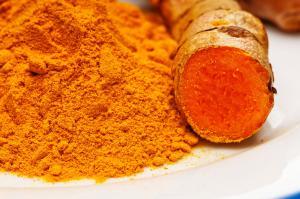Turmeric is a root that grows well in tropical climates and is the main ingredient in the Indian spice curry. What few people know is that turmeric is also one of the best all-around natural medicines that can be found. Turmeric can be used topically for skin related health issues or ingested for a wide array of internal health problems. You can also grow your own turmeric in containers in a windowsill to have a year-round supply of this important health supplement.
What is turmeric?
Turmeric is a bright yellow rhizomatous plant that is a member of the ginger family. It has been a staple spice of Indian and Asian cuisine for thousands of years. The bright yellow root is either used fresh or dried and ground into a powder that can then be added to food. The slightly bitter taste adds a unique flavor to many dishes while the bright orange color is used to add color to everything from rice to cheese to butters.
In addition to its culinary uses, turmeric has also been historically used as a natural medicine for a number of different uses. It is a main ingredient in Siddha medicine, a well-respected traditional medicine technique native to southern India. As a natural medicine, turmeric can be either ingested or used topically.
What gives turmeric its medicinal properties?
The main medicinal ingredient in turmeric is curcumin which is around 3% of turmeric once it is dried into powder. There are numerous studies that have identified curcumin as having a number of important health benefits, including anti-inflammatory, anti-fungal, and antibacterial properties.
A University of Maryland study found that using curcumin regularly may very well help to combat certain infections and even help your body to fight off certain cancers. A NCBI study similarly found that curcumin has strong anti-inflammatory properties and that these properties function through inhibiting different molecules in the body that cause inflammation.
The relative potent concentration of curcumin in turmeric allows turmeric to be used medicinally without any sort of alteration or chemical inputs. At the same time, it is mild enough that it isn’t known to cause any sort of major side effects or complications. Another study confirmed that the use of curcumin in clinical trials caused almost no noticeable side effects, making it a safe natural medicinal plant to use.
How to use turmeric topically
The night before their wedding, women from India historically have used a turmeric face mask to help prepare them for the marriage ceremony. When used topically, turmeric can help with skin rejuvenation. High in anti-oxidants, turmeric will help your skin to regain its natural glow and complexion.
Additionally, because of its proven anti-inflammatory properties, turmeric face masks, when used regularly, can help to treat more serious and chronic skin problems such as eczema and rosacea. Teenagers and adolescents dealing with acne problems can also use turmeric to help clear up any unwanted pimples and blemishes. The anti-fungal properties of turmeric also can help to avoid fungal infections on your skin.
One of the best ways to use turmeric topically is through making your own turmeric face mask. Simply add 1 teaspoon of turmeric powder to a little bit of water and mix until you get the desired consistency. You can also add other natural ingredients known for skin rejuvenation such as milk and oatmeal. Apply the cream to your face and let sit for 10 to 15 minutes before washing off with cold water.
Since turmeric will stain, it is important not to leave any sort of topical application of turmeric powder, paste or cream on your skin for more than 15 minutes. While you may notice a yellow “glow” to your skin after washing off the mask, the color will fade quickly.

How to use turmeric for internal problems
As we mentioned above, turmeric is known especially for its anti-inflammatory properties. It can be used to help people deal with arthritis and joint pain. Some National Football League players even use turmeric after every game to help them recover from the punishment of a physical game.
Furthermore, turmeric has been shown to help balance blood sugar, making it a great diet supplement for people who deal with diabetes and other blood sugar related conditions. Turmeric helps to regulate the blood sugar levels through affecting the insulin-producing cells of the pancreas called Beta cells and Islet cells.
Additionally, turmeric can help with cholesterol optimization, an important and necessary health area for millions of people around the world. Turmeric has been shown to help people reduce their cholesterol level and maintain it at an optimal level for long periods of time.
To use turmeric for aches and pains, blood sugar problems, arthritis, cholesterol issues, or any other number of health issues, it is best to take a turmeric supplement daily. You can use fresh turmeric or turmeric powder, but it is important to make sure that the powder you use is 100% pure turmeric and not adulterated with any sort of chemical food coloring or other additive. Turmeric can also be found as a liquid extract or capsules.

How to grow your own turmeric in container gardens
For people who want a steady supply of turmeric but don’t want to spend lots of money on sometimes expensive turmeric supplements or products, it is possible to grow turmeric at your home. Unless you live in a tropical area, however, you will need to keep your turmeric indoors.
Turmeric is native to warm Asian climates and if planted outdoors in a cold climate, it won’t make it through winter. However, turmeric can easily be grown in containers placed on a windowsill. Besides offering a steady supply of fresh turmeric roots, the beautiful flowers can also help to embellish your home.
To grow turmeric, you will first have to find a source of fresh turmeric root. Most grocery stores will only sell turmeric powders. If there is an Asian grocery store in your town, you have a much better chance of finding fresh turmeric root.
Choose the roots that have many buds or nodules on them. Each nodule will send up a new shoot which in turn grows more roots. Simply place the roots horizontally in a container filled with compost or garden soil and place them in a windowsill or a place in your home where they will receive a decent amount of light.
As long as you maintain your turmeric well-watered, you should be able to begin harvesting your first turmeric roots within 8 to 10 months. This YouTube video explains in detail how you can grow turmeric from root:
Turmeric for a healthier, natural life
While we may often express doubt at the many natural “miracle” cures that are trumpeted across the internet, turmeric truly is a unique natural product that offers an abundance of health enhancing properties. Whether you suffer from acne or dry skin, cholesterol problems, or arthritis, adding a small amount of turmeric to your diet is a great way to help you improve your health without having to worry about the side effects and complications from chemical medicines.
